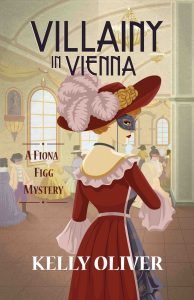Important Lessons I’ve Learned From Writing Historical Mysteries
 Do you like historical mysteries?
Do you like historical mysteries?
I do. I love reading historical mysteries—Elizabeth Peters’ Amelia Peabody, Jacqueline Winspear’s Maisie Dobbs, Rhys Bowen’s Georgiana Rannoch (and her standalones), Sujata Massey’s Perveen Mistry, and Mariah Frederick’s Jane Prescott, L.A. Chandlar’s Lane Sanders and more.
I also love writing historical mysteries. I’ve written nonfiction books, contemporary suspense, and children’s mysteries, but my historical series, the Fiona Figg Mysteries, is my favorite to write. Why?
I love doing the historical research. It is so fun to discover weird details about the past. And it is helpful to have real events to anchor the plot. For me, it makes writing easier. And I think readers are more interested in characters who are grounded in real life events and true crime.
I’ve learned a lot about writing since I started writing fiction. But there are some particular lessons I’ve learned from writing historical mysteries.
Historical Details Shape Plot and Setting
I love the fact that the details of history can help shape not only my plot but also the everyday lives of my protagonists. It’s like having a cheat-sheet.
The challenge, of course, is getting it right. And not just being accurate but also finding the right balance between historical details and story.
History can play so many roles in the novel, from those spicy tidbits sprinkled throughout the text, to the rich tapestry of everyday life that forms the background or setting for your story.
Since the Fiona Figg Mysteries are set in 1917 during WWI, I’ve learned about war strategy, early twentieth century British slang, what soldiers ate in the trenches, WWI female spies, and so many fun details.
Fiona’s nemesis throughout the series, Fredrick Fredricks, is based on a German spy named Fritz Duquesne, who was a fascinating character in real life. He was a spy for the Germans in both world wars (which means Fiona can chase him across the globe for years to come). He used various aliases, including Fredrick Fredricks. And, like a chameleon, he changed his looks, personality, and professions to evade capture. He is definitely a worthy adversary for Fiona.
Historical Research is Fun
 As a nerdy academic, I love doing the research! It’s so fun to look through old newspaper advertisements, or to use William Brohaugh’s English Through the Ages, Etymonline, or an old Baudeker’s guidebook.
As a nerdy academic, I love doing the research! It’s so fun to look through old newspaper advertisements, or to use William Brohaugh’s English Through the Ages, Etymonline, or an old Baudeker’s guidebook.
Of course, the Internet is a vast source of information about everything from the food and clothes of an era to the political events that shaped it. It’s amazing where you can find helpful information, especially stuff to help you paint a vivid picture of the details. First-hand accounts in documentaries, autobiographies, and nonfiction, are great resources too.
The second Fiona Figg Mystery, High Treason at the Grand Hotel, is set in Paris. So, I did a lot of research to learn what Paris was like in 1917.
A lot of famous American writers hung out in Paris during the war—Hemingway, Fitzgerald, e.e. Cummings, Dashiell Hammett, and Walt Disney. Many of them drove ambulances and volunteered with the war efforts. A few of them show up in High Treason at the Grand Hotel.
One figure captured my imagination. Margarethe Zelle, also known as Mata Hari. I read a great biography of Mata Hari by Pat Shipman called Femme Fatale. The fate of Mata Hari was determined in large part by the position of women in society in 1917, and that spoke to me. In all of my work, fiction and nonfiction, I have been concerned with women’s issues. And Mata Hari appears to be a victim rather than a perpetrator.
In spite of her disapproval of Mata Hari’s lifestyle, Fiona has a soft spot for her too.
The latest Fiona Figg Mystery, Villainy in Vienna is set… in Vienna. One of my favorite characters is Frau Anna Sacher. She was widowed young and took over running her husband’s hotel, the Sacher Hotel, which was known for its private rooms and discrete liaisons… and, of course, the famous Sacher Torte. Frau Sacher was rarely ever seen without a cigar in one hand and a French Bulldog in the other.
Emperor Charles and Empress Zita of Austria-Hungary and Mileva Einstein, the first wife of Albert Einstein, also play important parts in the story.
Anachronisms are Fascinating
Even the dreaded anachronism can be fascinating. What words and gadgets existed and when? Anachronisms are things or words used in the wrong time period, either because they didn’t exist yet, or because they were already out of use. There’s also the issue of region or place.
Words used here might not be used there, even in the same time period. For example, in the US we say “cafeteria” and in England they say “canteen.”
And on top of that, some words or things might feel out of place, even if they aren’t. Even though it would be fair game to use a phrase like “hang out” in a 19th Century novel, it might make your reader stop and question its accuracy. So, you need to use words that not only are right, but also sound like they’re right.
Facts versus Truth
It might sound like writing historical fiction is full of landmines and pitfalls, but those same challenges and obstacles can become a great help in fashioning a believable and engaging story. And, while emotions and reactions are also period and place dependent, a good historical novel adds the fleshy truth of experience to the bare bones of historical fact. A great historical novel makes people, places, and the past come alive.
How about you? What are your favorite historical novels? What do you look for in a historical mystery?
—
Kelly Oliver is the award-winning, bestselling author of three mysteries series: The Jessica James Mysteries, the middle grade Kassy O’Roarke, Pet Detective Mysteries, and historical cozies The Fiona Fig Mysteries. When she’s not writing mysteries, Kelly is Distinguished Professor of Philosophy at Vanderbilt University. To learn more about Kelly and her books, please visit her website at www.kellyoliverbooks.com.
—
 All of the Fiona Figg Mysteries are available in paperback, E-book, and audiobook wherever books are sold online.
All of the Fiona Figg Mysteries are available in paperback, E-book, and audiobook wherever books are sold online.
Villainy in Vienna, A Fiona Figg Mystery launched on January 4th. It is available at the special launch price of $2.99 until the end of January.
Buy it on Amazon: https://www.amazon.com/Villainy-Vienna-Fiona-Figg-Mystery-ebook/dp/B09NCQLLND
Barnes & Noble: https://www.barnesandnoble.com/s/fiona+figg/_/N-8qa
Find out more about the Fiona Figg Mysteries, including links to other online retailers: https://kellyoliverbooks.com/books/fiona-figg-mysteries/
Category: How To and Tips
























